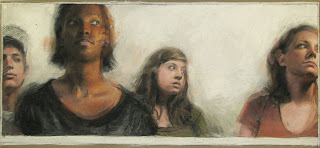In 2006, I was awarded a New Faculty Grant to research the technique of buon fresco. This award provided monetary support to study frescoes by Diego Rivera and Frederico Vigil in various locations throughout New Mexico and California. In addition to examining their frescoes, I was able to study the fundamentals of the technique under iLia Annosov in a week-long fresco workshop at the Fresco School in Los Angeles, CA. Feel free to visit my Fresco Trip blog to see my journey west!
After nearly a year of fresco exploration, I concluded my New Faculty Grant with an exhibit of frescoes created by WKU art students and myself. The exhibit took place in the University Gallery during the summer of 2008 and featured dozens of fresco tiles, portable five-layered frescoes, and educational models all of which introduced the technique to the audience. At the exhibit's opening, I was encouraged by WKU president Gary Randsdell to propose a larger work for the newly renovated Van Meter Auditorium.
Photo from the 2008 fresco exhibition in the University Gallery
As luck had it, I was assigned to teach at Harlaxton College in Grantham, England during the Spring of 2009. In addition to the visual impact that Harlaxton Manor had on my psyche (it's enormous!), I was conveniently situated near East Midlands Airport and a few hours away from most of Europe. With the financial support of a regular Faculty Grant from the Office of Sponsored Programs at WKU, I had the ability to visit Rome, Florence, and Campania where I visited the ancient Roman ruins of Pompeii.
Harlaxton Manor, Grantham, England
I was struck by the subtle differences between Rivera's fresco technique and those created by the masters from the Italian Renaissance. The Italian frescoes seemed to use more white paint - commonly referred to as "bianco san giovani"- that was at times thickly applied to the plaster's surface. In addition to technical details, I was able to experience the works in their natural setting and note how the artists used the paintings (and sculptures) as well as scale to create awe-inspiring psychological experience for the viewers.
Two works from my journeys in Italy had a direct impact on the concept for the Van Meter fresco. The first, Michelangelo's sculpture, David, literally stopped me in my tracks when I came upon it. I was amazed at how a giant 4' marble hand could evoke such a strong psychological experience. In more than one way the work felt larger than me. In the Van Meter fresco, the monumental scale of the student-figures was a homage to Michelangelo's, David.
Photo by Clayton Tang
A second point of inspiration albeit less direct, came from viewing the ceiling of the Sistine Chapel, by Michelangelo. Arguably the most famous fresco in history, it is an access point for those interested in the technique particularly in our own age as a result of media coverage surrounding the frescoes' restoration in the 1980s. I hope my project will in some small way bring the technique of fresco down from the ceiling to inspire investigation by those in my community.
In many ways, Van Meter Auditorium is an ideal location for a fresco mural. The building's architecture harks back to a classical age. I am pleased with the placement of the mural inside Van Meter, how it both activates and is activated by the space. Rather than seeing the fresco from a distance, for example from the floor to the ceiling, the slender passageway forces the audience closer to the mural and subsequently reveals clues about the medium's technical process.
Frescoes were popular in the US during the Great Depression due to funding through WPA and Post Office commissions. The technique itself was made popular by Mexican Muralists such as Diego Rivera and José Clemente Orozco. As public works, the murals were commonly installed in institutional and governmental buildings that have much in common with Van Meter Auditorium.
In addition to being an educational tool, the choice of technique also nods to the past. The subjects in the mural signify the present as the models were students at the time of the mural's construction. They are in a state of flux and look outward to an unknown and uncertain future just beyond the picture plane.
Preliminary stage in charcoal
Preliminary stage in color pastel





No comments:
Post a Comment